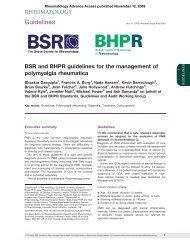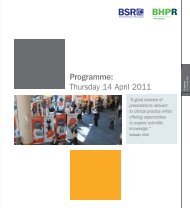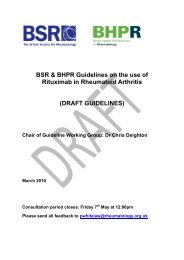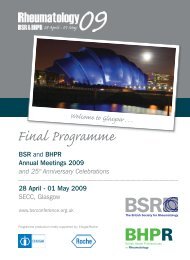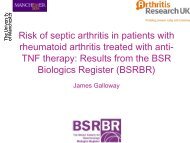Guidelines for the treatment of psoriatic arthritis with biologics
Guidelines for the treatment of psoriatic arthritis with biologics
Guidelines for the treatment of psoriatic arthritis with biologics
Create successful ePaper yourself
Turn your PDF publications into a flip-book with our unique Google optimized e-Paper software.
TREATMENT OF PERIPHERAL ARTHRITIS (POLYARTICULAR DISEASE)<br />
The majority <strong>of</strong> clinical trials in PsA have focused on <strong>treatment</strong> <strong>of</strong> peripheral <strong>arthritis</strong> in polyarticular disease.<br />
A summary <strong>of</strong> results from RCTs <strong>of</strong> anti‐TNF <strong>the</strong>rapies in PsA is shown in table 1. The eligibility criteria <strong>for</strong><br />
entry into <strong>the</strong> majority <strong>of</strong> <strong>the</strong>se trials were three or more tender joints and three or more swollen joints,<br />
although <strong>the</strong> trials show far higher median or mean joint counts than <strong>the</strong> minimum required. Most trials <strong>of</strong><br />
anti‐TNF <strong>the</strong>rapies also required patients to have failed a <strong>the</strong>rapeutic trial <strong>of</strong> ei<strong>the</strong>r non‐steroidal antiinflammatory<br />
drugs (NSAIDs) and/or DMARDs to qualify <strong>for</strong> inclusion. An adequate <strong>the</strong>rapeutic trial <strong>of</strong> a<br />
DMARD is usually defined as failure to tolerate a drug or active disease despite <strong>treatment</strong> <strong>of</strong> at least 12 weeks<br />
<strong>with</strong> a target <strong>the</strong>rapeutic dose. Un<strong>for</strong>tunately, very little good quality evidence is available to support <strong>the</strong> use<br />
<strong>of</strong> most syn<strong>the</strong>tic DMARDs in PsA as few RCTs assessing syn<strong>the</strong>tic DMARDs are available. Modest efficacy has<br />
been shown <strong>for</strong> sulfasalazine (SSZ) [6] and LEF[7] <strong>with</strong> conflicting evidence concerning methotrexate (MTX)[8].<br />
A full assessment <strong>of</strong> evidence <strong>for</strong> DMARD effectiveness was beyond <strong>the</strong> scope <strong>of</strong> <strong>the</strong>se guidelines that has<br />
focused on biological <strong>treatment</strong>s. There is also little evidence to base a judgement on how many DMARDs<br />
should be failed be<strong>for</strong>e considering biological <strong>the</strong>rapy. Most anti‐TNF trials included patients who were ei<strong>the</strong>r<br />
DMARD‐naïve, those who had failed just one DMARD or those who had failed multiple DMARDs <strong>with</strong> little<br />
evidence to compare outcome based on previous DMARD stratification.. To date, <strong>the</strong>re is only one open label<br />
trial comparing outcomes <strong>of</strong> MTX‐naïve patients starting MTX or anti‐TNF <strong>the</strong>rapy [9]. DMARDs are widely<br />
used in clinical practice <strong>for</strong> <strong>the</strong> <strong>treatment</strong> <strong>of</strong> PsA in <strong>the</strong> UK and anecdotal and observational data support <strong>the</strong>ir<br />
use. In light <strong>of</strong> <strong>the</strong> paucity <strong>of</strong> evidence, <strong>the</strong> consensus opinion <strong>of</strong> <strong>the</strong> guideline group was that in most cases,<br />
patients should have had adequate <strong>the</strong>rapeutic trials <strong>of</strong> two standard DMARDs (ei<strong>the</strong>r sequentially or in<br />
combination) prior to <strong>the</strong> prescription <strong>of</strong> biological <strong>the</strong>rapies. An adequate <strong>the</strong>rapeutic trial is defined ei<strong>the</strong>r<br />
as failure to tolerate a DMARD or active disease despite <strong>treatment</strong> <strong>of</strong> at least 12 weeks at target <strong>the</strong>rapeutic<br />
dose <strong>of</strong> a conventional DMARD. The length <strong>of</strong> <strong>treatment</strong> constituting a <strong>the</strong>rapeutic trial has been shortened in<br />
comparison <strong>with</strong> <strong>the</strong> 2005 guidelines to keep <strong>the</strong> guidelines in line <strong>with</strong> current advised practice in RA [2].<br />
5




